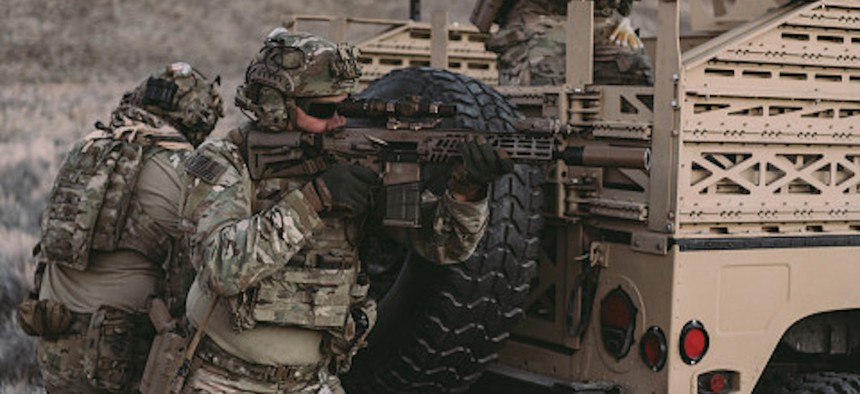
Promotional image of one of the new weapons selected by the Army. Sig Sauer
Soldiers Will Have to Wait Until Next Year for New Rifle, Ammo
Sig Sauer’s decade-long contract to make the weapons leads off with a tiny order for quality testing.
The much-anticipated replacements for the U.S. Army’s rifle and light machine gun will slowly work their way into soldiers’ hands as gun manufacturer Sig Sauer ramps up production in the coming years, service officials said Wednesday.
The first troops to receive the XM5 rifle and the XM250 automatic rifle—which unit is still being decided—will get them around the fourth quarter of 2023, Brig. Gen. Larry Burris, who leads the soldier lethality cross-functional team, told reporters at the Pentagon. Exactly when the weapons will be fielded depends largely on when enough of their 6.8mm ammunition—a new caliber for the Army—can be manufactured.
“As the vendor is able to produce ammunition and then Lake City [Army Ammunition Plant] ultimately comes on—what we don't want to do is field a capability to a unit where we don't have training ammunition or contingency ammunition if required,” he said.
Replacing the M4/M4A1 carbine and the M249 Squad Automatic Weapon has been among the service’s top modernization priorities for half a decade. The Army launched the Next Generation Squad Weapons program in 2018 following a study; prototyping and evaluation began a year later.
On Tuesday, the Army announced that Sig Sauer had won the 10-year contract to build the new weapons to its design, beating out General Dynamics and Textron Systems.
Burris hailed the 27-month competition, saying the Army would traditionally have taken eight to 10 years to develop and choose a new rifle.
“We should note that this is the first time in our lifetime—the first time in 65 years—the Army will field a new weapon system of this nature: a rifle, an automatic rifle, a fire control system, and a new caliber family of ammunition. This is revolutionary,” he said.
The new weapons, which will be equipped with the new Vortex fire control component and a suppressor, will go to “close combat” troops like infantry and cavalry scouts; other soldiers and units will continue to use M4s and M249s.
“Both weapons provide significant capability improvements in accuracy, range and overall lethality. They are lightweight, fire more lethal ammunition, mitigate recoil, provide improved barrel performance, and include integrated muzzle sound and flash reduction,” said the Army statement.
The new 6.8mm ammunition has also been designed to be more lethal than the 5.56mm and 7.62mm ammunition used for decades by U.S. and other NATO forces. The Army will not stop buying the older rounds because some troops will still carry M4s and M249s, officials said.
Sig Sauer will make the new ammunition until 2026, when a new building will be completed and start producing the rounds at Lake City, an 81-year-old government-owned ammunition plant in Independence, Missouri.
The company’s 10-year contract starts with a tiny production order: about 25 rifles, 15 automatic weapons, and a “large quantity” of ammunition, Col. Scott Madore, the project manager of soldier lethality. The $20.4 million order will produce weapons for testing and allow the company to fine-tune its production process.
Ultimately, the Army intends to buy about 107,000 XM5s and 13,000 XM250s, to outfit about 120,000 close-combat troops, Burris said. The pace of the orders will depend on annual budget decisions and other factors, he said.
The up-to-$4.7 billion contract also has an option that allows the Army to order up to 250,000 weapons if the other services are interested in adopting the weapon, Madore said.
He said the Marine Corps offered feedback on the prototypes during testing and has expressed interest in the weapons.




